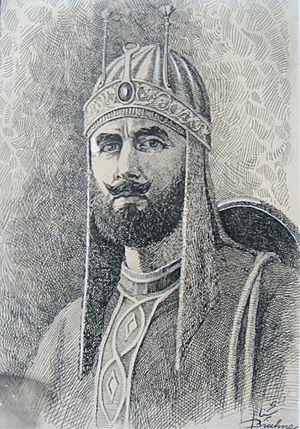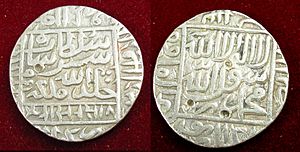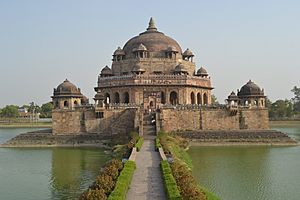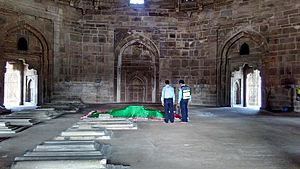Sher Shah Suri facts for kids
Quick facts for kids Sher Shah Suri |
|||||
|---|---|---|---|---|---|
| Padishah | |||||

Imagined sketch of Sher Shah Suri by Afghan artist Abdul Ghafoor Breshna
|
|||||
| 1st Sultan of the Suri Empire | |||||
| Reign | 1537 – 22 May 1545 | ||||
| Coronation | 18 May 1538 | ||||
| Predecessor | Humayun (as Mughal Emperor) | ||||
| Successor | Islam Shah Suri | ||||
| Born | 1472, or 1486 Sasaram, Delhi Sultanate (now in Bihar, India) |
||||
| Died | 22 May 1545 (aged 73, or 59) Kalinjar |
||||
| Burial | Sher Shah Suri Tomb, Sasaram | ||||
| Spouse | Utmadun Nissa Bano Begum Rani Shah |
||||
| Issue | Islam Shah Suri (Jalal Khan) Adil Khan {Jawwad Khan Suri} is the great-grandson of Sher Shah Suri |
||||
|
|||||
| House | House of Sur, who claimed descendants from the House of Ghor | ||||
| Dynasty | Sur Dynasty | ||||
| Father | Hassan Khan Sur | ||||
| Religion | Sunni Islam | ||||
Sher Shah Suri (born Farīd Khān, around 1472 or 1486 – May 22, 1545) was a powerful ruler in India. He founded the Sur Empire, with its capital in Sasaram, which is now in Bihar, India. Sher Shah took control of the Mughal Empire in 1540 CE. He was known for making many important changes to how the empire was run.
Before becoming an emperor, Sher Shah started as a soldier. He rose through the ranks in the Mughal army under Babur. Later, he became the governor of Bihar. In 1537, while Babur's son Humayun was away, Sher Shah took over the state of Bengal. This is how he started the Suri dynasty.
Sher Shah was a very smart leader and a skilled general. He was also a great administrator. His changes to the empire helped set the stage for later Mughal emperors, especially Akbar, who was Humayun's son. During his five-year rule (1540-1545), he created new systems for the economy and the military. He also introduced the first Rupiya coin and set up an organized postal system in the Indian Subcontinent.
Many of his ideas and contributions were later used by the Mughal emperors, especially Akbar. Sher Shah also improved Humayun's city, Dina-panah, and renamed it Shergarh. He also brought back the old city of Pataliputra, which had been in decline, and renamed it Patna. He even extended the famous Grand Trunk Road from Chittagong (in modern-day Bangladesh) all the way to Kabul in Afghanistan. His changes had a lasting impact, and even his rival, Humayun, called him “Ustad-I-Badshahan,” meaning "teacher of kings."
Contents
Early Life and Rise to Power
Sher Shah Suri was born Farid Khan. Historians believe he was born in Narnaul around 1486, or in Sasaram around 1472. His grandfather, Ibrahim Khan Sur, started as a horse trader and later became a landlord in the Narnaul area. Farid's father, Hassan Khan, was given control of Sasaram and Khawaspur-Thanda.
Farid was one of Hassan Khan's eight sons. He went to Jaunpur to study literature, poetry, and history. His family name, 'Suri', came from his Sur tribe, which was a Pashtun tribe. The name Sher means lion or tiger in Persian. He earned this name when he was young because he bravely killed a tiger that attacked the king of Bihar.
Becoming a Powerful Ruler
Farid Khan began his career working for Bahar Khan Lohani, the Mughal Governor of Bihar. Because he was so brave, Bahar Khan gave him the title Sher Khan (meaning Lion Lord). After Bahar Khan died, Sher Khan became the temporary ruler for the young Sultan, Jalal Khan.
As Sher Khan's power grew in Bihar, Jalal asked Ghiyasuddin Mahmud Shah, the Sultan of Bengal, for help. Ghiyasuddin sent an army, but Sher Khan defeated them in the Battle of Surajgarh in 1534. He did this by forming alliances with Ujjainiya Rajputs and other local leaders. This victory gave him complete control of Bihar.
In 1537, Sher Khan attacked Bengal and defeated Ghiyasuddin Mahmud Shah. However, he couldn't fully take over the kingdom because Emperor Humayun suddenly arrived. On June 26, 1539, Sher Khan fought Humayun in the Battle of Chausa and won. He then took the title Farīd al-Dīn Shēr Shah. In May 1540, he defeated Humayun again at Kannauj, forcing him to leave India.
Expanding the Empire
After becoming emperor, Sher Shah continued to expand his empire.
Conquest of Malwa
In 1542, Sher Shah conquered Malwa Sultanate without a fight. The previous ruler, Qadir Shah, fled. Sher Shah then appointed Shuja'at Khan as the governor of Malwa.
Conquest of Marwar
In 1543, Sher Shah Suri led a large army of 80,000 soldiers against Maldeo Rathore, the Rajput king of Marwar. Maldeo Rathore had an army of 50,000 soldiers. After a month of small fights, Sher Shah's army faced problems with food supplies.
To solve this, Sher Shah used a clever trick. He left fake letters near Maldeo's camp, making it look like some of Maldeo's commanders were secretly helping Sher Shah. Maldeo believed the letters and wrongly thought his commanders were disloyal. He left for Jodhpur, abandoning his generals.
Maldeo's loyal generals, Jaita and Kumpa, fought bravely with only a few thousand men against Sher Shah's much larger army. In the Battle of Sammel (also called Giri Sumel), Sher Shah won, but his army suffered heavy losses. Sher Shah famously said that "for a few grains of bajra (millet), I almost lost the entire kingdom of Hindustan." After this victory, Sher Shah's general took control of Jodhpur and the Marwar region.
Sher Shah's Government and Reforms

Sher Shah introduced a new system for money. He created the rupee, a silver coin that weighed 178 grains. This was the first version of the modern rupee used today in countries like India, Pakistan, and Sri Lanka. He also minted gold coins called Mohur and copper coins called Paisa.
He was also responsible for greatly improving and modernizing the Grand Trunk Road. This major road stretched from modern-day Bangladesh to Afghanistan. Along the road, he built caravanserais (inns) and mosques. He also planted trees for shade and dug wells for travelers. Sher Shah also set up a very efficient postal system, where mail was carried quickly by horse riders.
Sher Shah built several important structures, including:
- Rohtas Fort (a UNESCO World Heritage Site in Pakistan).
- Many buildings within the Rohtasgarh Fort in Bihar.
- The Sher Shah Suri Masjid in Patna.
- The Qila-i-Kuhna mosque inside the Purana Qila complex in Delhi.
- The Sher Mandal, an octagonal building also in the Purana Qila complex, which later became Humayun's library.
- A new city called Bhera in present-day Pakistan in 1545, which included a grand mosque named after him.
Historians generally see Sher Shah as a ruler who was fair to Hindus, except for one tragic event after the surrender of Raisen. The book Tarikh-i-Sher Shahi (History of Sher Shah), written by Abbas Khan Sarwani, gives a detailed account of Sher Shah's administration.
Death and Legacy

Sher Shah began the siege of Kalinjar fort in 1543. On May 22, 1545, he was killed during this siege. He ordered the fort walls to be blown up with gunpowder. However, he was badly wounded when a mine exploded. His son, Jalal Khan, continued the siege and took the title of Islam Shah Suri.
Sher Shah's tomb, a tall building (122 feet high), stands in the middle of an artificial lake in Sasaram. This town is located on the Grand Trunk Road.
Impact on Cities
Some historians say that Sher Shah destroyed old cities to build new ones named after himself. For example, Shergarh is now a ruined town, but it used to be a busy place where different religions lived together. Sher Shah is also said to have destroyed Dinpanah, a city that Humayun was building in Delhi. The new city Sher Shah built, Shergarh, was itself destroyed in 1555 after Humayun took back control from the Sur rulers.
See also
 In Spanish: Sher Shah Suri para niños
In Spanish: Sher Shah Suri para niños
- Isa Khan Niazi
- Haibat Khan Niazi
- Shere Khan
- Pathans in Bihar
- List of rulers of Bengal
- Jahangir Kabir (politician)
- History of Bangladesh
- History of India
- Shershabadia community


